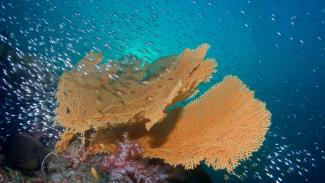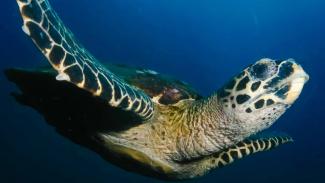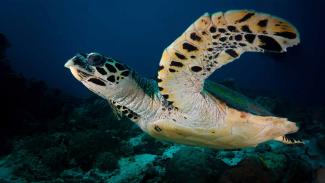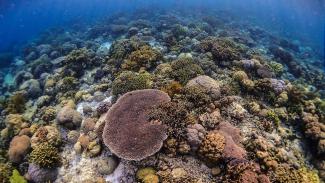Everything you need to know about dving around Lankayan Island
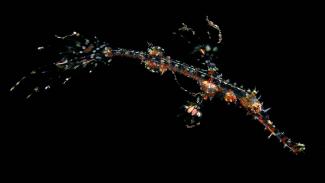
The picturesque island of Lankayan is now regarded as one of Malaysia’s finest dive destinations.
The island, which is just off east the coast of Borneo in the Sulu Sea, has only one resort, ensuring uncrowded dive sites and plenty of relaxation.
Just a few minutes from the island are numerous interesting dive sites, including three wrecks, plenty of macro life, some colourful reefs & - in season - the chance to see Whalesharks.
Highlights
Best diving spots
Just a few minutes from the island are numerous interesting dive sites, including 3 wrecks, plenty of macro life, some colourful reefs & - in season - the chance to see Whalesharks. A couple of kilometres to the south of Lankayan is Jawfish Layer. This site has an excellent variety of both hard & soft corals and is a favourite site. It is possible to find all manner of macro delights here - many Frogfish lie perfectly camouflaged in ambush, Ghost Pipefish are common, quite a few different species of Nudibranch’s can be found and even the elusive Mimic Octopus can be seen here if you are lucky.
Further south, the Katcing Group of islands have some dive sites that are also good for small things, especially Nudibranch's. The area also has some larger inhabitants. Look on the sand and you will see the eyes of Stingrays cautiously following you, while Leopard Sharks can also be seen taking a nap. The site gets its name from the Yellow Jawfish though. This curious-looking fish can be found in with its head sticking out of the rubble. Look closely, and you may notice that its mouth is full of tiny eggs.
Moskito Wreck, just to the east of Lankayan, is a great wreck for diving. The Japanese ship came to grief in WWII and now sits between 10 and 25 metres of water in calm conditions, allowing divers plenty of time to uncover its mysteries. The ship is in excellent condition, the main structure is still intact and the ship’s gun still perches proudly on the bow.
Barracuda & large schools of Trevally are often seen around the wreck, while the structure itself is an excellent spot to look for small critters. Lankayan Wreck & another small wreck just off the main jetty are also good dives, with plenty of macro delights to be found, including Ornate Ghost Pipefish & Painted Frogfish. To the north are more enjoyable shallow reefs with excellent corals that hide plenty of unusual life.
The big draw of the area is the seasonal appearance of Whale Sharks though. Around April & May, Lankayan is an excellent place to encounter these gentle giants as they cruise past on their ancient migration routes.
Turtles are also fairly common and the island itself is a breeding ground for both Green & Hawksbill Turtles. Bumphead Parrotfish & large Groupers are also regularly seen, as are Octopus & Cuttlefish. Those who are really lucky may even bump into a docile Dugong.
When to dive
Lankayan can be dived year-round, offering easy diving, calm seas & an excellent diversity of life. April & May is the time for Whale Shark encounters
Getting there
The island is reached by boat from Sandakan on the mainland. The closest major airport is Kota Kinabalu, the capital of Sabah in the north of the state.
Activities
Once the diving is over, relaxing, enjoying the picture perfect setting & marvelling at the island's tranquility are about as active as Lankayan gets.
Resort and liveaboard options
Lankayan has one sole dive resort with an excellent reputation. Lankayan Island Dive Resort offers well appointed chalets for guests and offers daily diving to all the best local dive sites. The resort will also arrange transfers to Lankayan Island.
You might also enjoy...
Underwater housing care
Jakob Owens
Buying all the kit to allow you to take photos underwater is not cheap, so you need to make your equipment lasts the test of time.
One of the major and most vital expenses is your underwater housing. Housings are often fragile and can require a lot of care and attention though. So what should you be doing to look after your housing and to make sure it has a happy and healthy life?
Similan & Surin Islands
The Similan Islands in Thailand are the country's most famous diving destination, offering great visibility, stunning corals and prolific marine life.
Accessed primarily by liveaboard, the Similan Islands are in a strictly controlled marine park and are considered by many to be the crown jewels of Thailand’s diving. As well as the diving, they also offer picture perfect beaches and unspoilt habitats.
Bohol
The island of Bohol lies just to the east of Cebu in the Viasayas region of the Philippines and is a popular island for tourists.
The area's diving is also a major attraction, with great macro life, plentiful turtles and lovely coral reefs. Good diving options are available on the west coast, and also the quieter south-east region of Anda.
Lombok & Gili Islands
In north-west Lombok, the Indonesian island to the east of Bali, are three idyllic islands known collectively as the Gili Islands.
These small islands, as well as being beautiful above water, also offer a visual feast below the waves, with plenty of turtles & other great marine animals.
The islands, which have no cars and a very relaxed way of life, have become the most popular spot in Indonesia to learn to dive.
Choosing the right dive spot
Phil North



